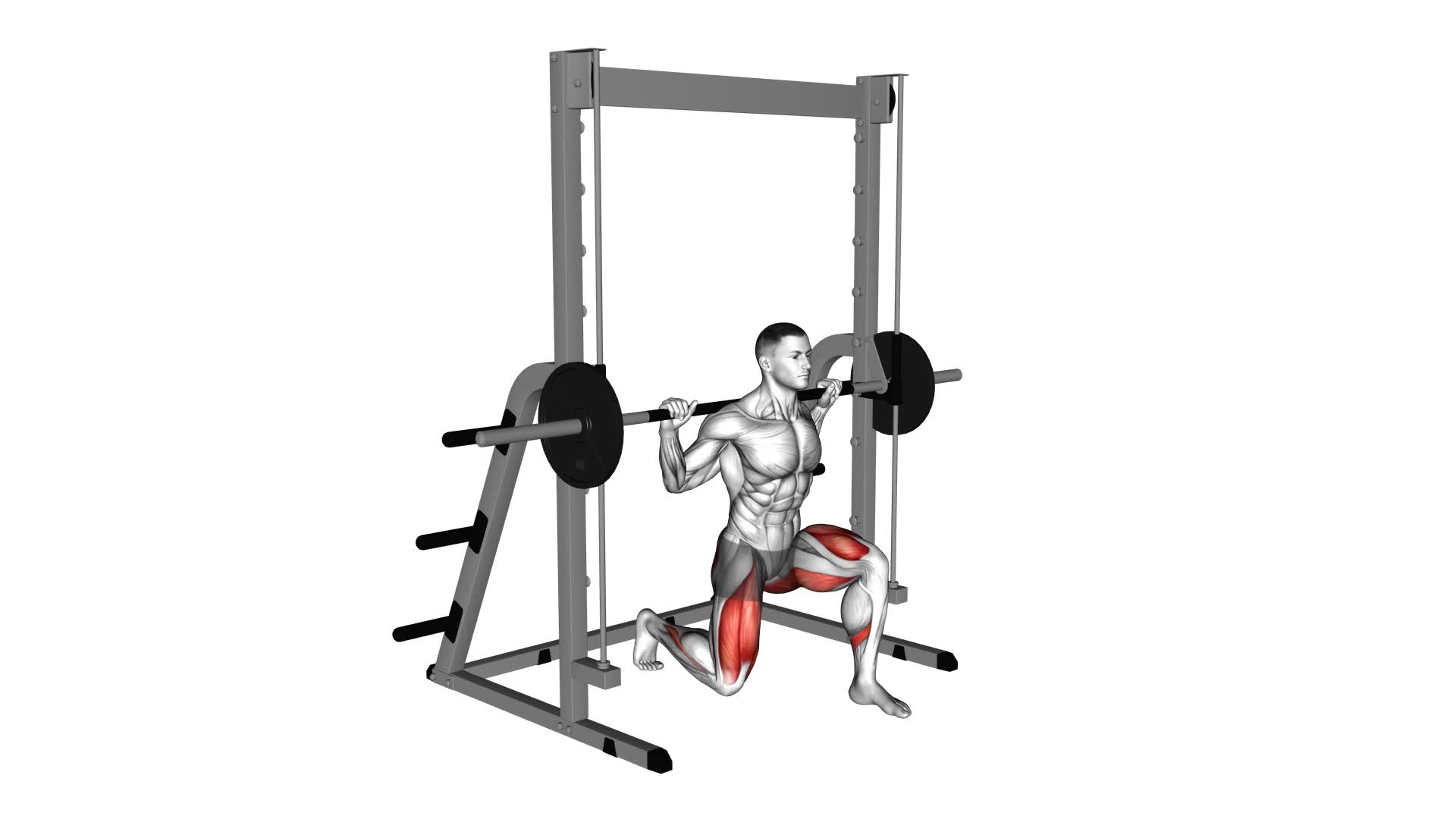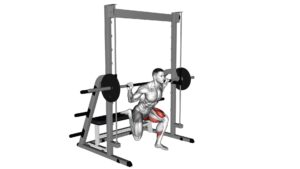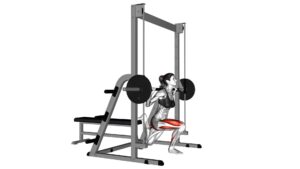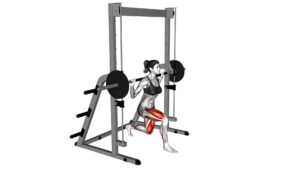Smith Split Squat – Video Exercise Guide & Tips

Looking to strengthen your lower body? The Smith Split Squat is a great exercise to add to your routine.
Watch This Exercise Video
In this video exercise guide, we'll show you the proper form and technique for performing the Smith Split Squat.
We'll also share common mistakes to avoid and helpful tips for maximizing your results.
Get ready to feel the burn and level up your leg workout with the Smith Split Squat.
Let's dive in!
Key Takeaways
- The Smith Split Squat targets multiple muscle groups in the lower body, including the glutes, quads, and hamstrings.
- Engaging the core muscles throughout the exercise is important for maintaining stability and proper form.
- It is crucial to keep the chest up and the back straight during the Smith Split Squat.
- Distributing the weight evenly between both legs and avoiding allowing the front knee to go past the toes are essential for proper technique.
Benefits of the Smith Split Squat
- There are five key benefits you can experience from incorporating the Smith Split Squat into your workout routine. This exercise is a powerful tool for improving balance and increasing lower body strength.
Firstly, the Smith Split Squat targets your glutes, quads, and hamstrings. By working these muscles, you can expect to see significant improvements in your lower body strength. This exercise allows you to focus on each leg individually, ensuring balanced development and preventing muscle imbalances.
Secondly, the Smith Split Squat engages your core muscles. As you stabilize your body during the movement, your abdominal muscles are activated, leading to improved core strength and stability.
Thirdly, this exercise promotes better balance and coordination. By challenging your stability and control, the Smith Split Squat helps strengthen the muscles responsible for maintaining balance, reducing the risk of falls and injuries.
Additionally, incorporating the Smith Split Squat into your workout routine can enhance your overall athletic performance. The exercise mimics movements used in sports and daily activities, making it a functional exercise that translates into improved performance in various physical activities.
Lastly, the Smith Split Squat can be modified to suit different fitness levels. Whether you're a beginner or an advanced athlete, you can adjust the weight, range of motion, and intensity to meet your specific needs and goals.
Incorporating the Smith Split Squat into your workout routine can lead to improved balance, increased lower body strength, enhanced core stability, better coordination, and enhanced athletic performance. So why wait? Give it a try and experience the benefits for yourself.
Proper Form and Technique for the Smith Split Squat
To perform the Smith Split Squat with proper form and technique, it's important to maintain a stable stance and engage your core muscles throughout the exercise. Start by standing in front of the Smith machine, with your feet shoulder-width apart. Place your back foot on the bar of the Smith machine, ensuring that your toes are pointing slightly outward. Your front foot should be positioned far enough in front of you so that when you lower into the squat, your knee doesn't go past your toes.
As you lower into the squat, keep your chest up and your back straight. Make sure to distribute your weight evenly between both legs, and avoid leaning too far forward or backward. To maintain balance, engage your core muscles and focus on keeping your body centered.
Now, let's talk about some common mistakes to avoid. One of the most common mistakes is allowing your front knee to go past your toes. This not only puts unnecessary strain on your knee joint but also compromises the effectiveness of the exercise. Another mistake isn't maintaining proper posture. It's important to keep your chest up and your back straight throughout the movement.
Lastly, let's discuss some variations and modifications you can make to the Smith Split Squat. If you're a beginner, you can start by performing the exercise without any weights. As you progress, you can add dumbbells or a barbell to increase the intensity. Additionally, you can try different foot placements, such as elevating your front foot on a step or using a wider stance, to target different muscles. Remember to always listen to your body and adjust the exercise to your fitness level.
Common Mistakes to Avoid During the Smith Split Squat
To avoid common mistakes during the Smith Split Squat, make sure you don't allow your front knee to go past your toes. This is a crucial aspect of maintaining proper technique and preventing injury.
Allowing your front knee to extend too far forward puts excessive strain on the knee joint and can lead to discomfort or even pain. Instead, focus on keeping your front knee aligned with your ankle throughout the movement. This ensures that the majority of the work is being done by your glutes and hamstrings, rather than placing unnecessary stress on your knee.
Another common mistake to avoid isn't maintaining proper balance and stability. Make sure to engage your core and keep your upper body upright throughout the exercise. This will help you maintain control and prevent any unnecessary wobbling or swaying.
Variations and Modifications for the Smith Split Squat
For different variations and modifications of the Smith Split Squat, you can incorporate additional resistance, such as dumbbells or a barbell, to increase the intensity of the exercise. By using different equipment, you can target your muscles in new ways and challenge yourself further.
One advanced modification is the Smith Split Squat with dumbbells. Hold a dumbbell in each hand, with your palms facing inward, and perform the split squat as usual.
Another modification is the Smith Split Squat with a barbell. Place a loaded barbell across your upper back and perform the exercise in the same manner. These variations require more stability and strength, making them ideal for advanced individuals looking to take their workout to the next level.
Remember to start with lighter weights and gradually increase the resistance as you become more comfortable and confident.
Now that you know about the different equipment and advanced modifications for the Smith Split Squat, let's move on to the next section, where we'll discuss some tips for maximizing your results with this exercise.
Tips for Maximizing Your Results With the Smith Split Squat
Maximize your results with the Smith Split Squat by focusing on proper form and engaging your muscles throughout the exercise. One important tip for maximizing your results is to prioritize stability during the Smith Split Squat. Maintaining stability not only helps to prevent injury but also ensures that you're effectively targeting the muscles you intend to work. To enhance stability, make sure to keep your core engaged and maintain a neutral spine throughout the movement. Additionally, distribute your weight evenly between your front and back foot, and avoid any excessive sway or wobbling.
Another way to maximize your results with the Smith Split Squat is to incorporate it into a full body workout routine. This exercise primarily targets the lower body muscles, including the quadriceps, hamstrings, and glutes. However, you can also engage your core and upper body by adding variations such as holding dumbbells or performing a bicep curl while in the split squat position. By incorporating the Smith Split Squat into a well-rounded workout routine that includes exercises for other muscle groups, you can achieve a comprehensive full body workout.
Frequently Asked Questions
How Many Sets and Reps Should I Do for the Smith Split Squat?
To determine the number of sets and reps for the Smith split squat, you need to consider your fitness goals and current fitness level. It's generally recommended to start with 3 sets of 8-12 reps for beginners and gradually increase as you get stronger.
The Smith split squat benefits your lower body by targeting your quads, glutes, and hamstrings. However, be cautious of common mistakes like leaning forward or using too much weight, which can strain your knees and compromise your form.
Can I Use Dumbbells Instead of the Smith Machine for This Exercise?
Yes, you can definitely use dumbbells instead of the Smith machine for the split squat exercise.
Using dumbbells as an alternative to the Smith machine offers several benefits.
It allows for a greater range of motion, engages more stabilizer muscles, and promotes better balance and coordination.
Additionally, using dumbbells can help improve overall strength and muscle development.
Is the Smith Split Squat Suitable for Beginners?
The Smith Split Squat is a great exercise for beginners. It helps improve lower body strength and stability. To perform it with proper form, start by standing in a split stance with one foot forward and the other foot back. Lower your body down until your front knee is at a 90-degree angle. Make sure to keep your chest up and your back straight.
Common mistakes include leaning too far forward or not going low enough. Beginners can modify this exercise by using a bench for support or holding onto a stable object for balance.
As you progress, you can increase the weight or try more challenging variations.
What Muscles Does the Smith Split Squat Primarily Target?
The smith split squat is a great exercise for targeting multiple muscles in your lower body. It primarily works your quadriceps, hamstrings, and glutes. By incorporating this exercise into your lower body workout routine, you can experience various benefits such as improved leg strength, increased muscle mass, and enhanced balance and stability.
Additionally, there are different variations of the split squat that can help target specific muscle groups, allowing you to customize your workout based on your goals.
Can I Incorporate the Smith Split Squat Into My Leg Day Workout Routine?
Sure, you can definitely incorporate the Smith split squat into your leg day workout routine. It's a great exercise for targeting your quads, hamstrings, and glutes. If you're looking for alternatives, you can try lunges or Bulgarian split squats.
To maximize results, make sure to maintain proper form by keeping your back straight, chest up, and knees in line with your toes. This will help you get the most out of the exercise and prevent injury.
Conclusion
In conclusion, the Smith Split Squat is a highly effective exercise for targeting the lower body muscles and improving overall strength and stability.
By following proper form and technique, avoiding common mistakes, and incorporating variations and modifications, you can maximize your results with this exercise.
Remember to consult with a fitness professional or trainer if you have any concerns or questions about incorporating the Smith Split Squat into your workout routine.

Author
Years ago, the spark of my life’s passion ignited in my mind the moment I stepped into the local gym for the first time. The inaugural bead of perspiration, the initial endeavor, the very first surge of endorphins, and a sense of pride that washed over me post-workout marked the beginning of my deep-seated interest in strength sports, fitness, and sports nutrition. This very curiosity blossomed rapidly into a profound fascination, propelling me to earn a Master’s degree in Physical Education from the Academy of Physical Education in Krakow, followed by a Sports Manager diploma from the Jagiellonian University. My journey of growth led me to gain more specialized qualifications, such as being a certified personal trainer with a focus on sports dietetics, a lifeguard, and an instructor for wellness and corrective gymnastics. Theoretical knowledge paired seamlessly with practical experience, reinforcing my belief that the transformation of individuals under my guidance was also a reflection of my personal growth. This belief holds true even today. Each day, I strive to push the boundaries and explore new realms. These realms gently elevate me to greater heights. The unique combination of passion for my field and the continuous quest for growth fuels my drive to break new ground.







